Technical details
The railcar was designed taking advantage of the experience developed in the construction of two decks vehicles gained in Italy by the Casaralta workshops (Bologna) in building railways carriages derived from those in service on the Parisian "banlieue" and supplied to Ferrovie Nord Milano and Ferrovie dello Stato companies. Such vehicles were built under CIMT Lorraine (a French firm) license.
The experiment was focused on the research on a lightweight vehicle with higher capacity than railcars used at that time. The objective was to provide regional and branch lines with such vehicles, with an offer estimated at about 40-50% more passengers than equivalent traditional railcars, despite the "low power consumption and a saving of about 20% in investment and running costs".
It was designed a curious double-decker railcar reminiscent of the similar coaches of the time. The vehicle was built by a company called Cafici International, with headquarters in Geneva; the name came from the initials of the three partners who formed that consortium: Casaralta (Bologna, Italy) CIMT- Lorraine (France) and Fiat Ferroviaria (Savigliano, Italy), a specialist in the construction of lightweight material.
The engine was supplied by Fiat (Iveco 828 SRI engine 4-stroke, 8-cylinder V) and installed in only one of the two carriages, which were derived from those equipped on the double-decker coaches then being delivered by Casaralta, with secondary air suspension and brake discs and mixed strains.
The arrangement of space was such as to create in practice four distinct rooms: the two vestibules allow access to the front and rear rooms, a total capacity of 17, and the two central decks, with a capacity of 60 seats respectively the upper and 48 lower.
History
Released from the factory in 1982, the following year the vehicle was tested on some lines in Piemonte region, covering several times the Turin-Trofarello and Fossano-Limone Piemonte paths.
In 1984, after several weeks of testing on the ACT (Reggio Emilia) network and along the Suzzara-Ferrara Railway (FSF), [1] the railcar moved back in Piemonte and in the French Riviera, where on behalf of the SNCF was the subject of different test runs on the Cuneo-Nice, where the low power of the one engine was put to the test by ramps imposed by the Maritime Alps, highlighting not brilliant performances.
The FIAT organized later, in 1986, a further series of test runs on Brescia-Iseo-Edolo (Valcamonica railway) whose owner, SNFT, judged the railcar unsuitable for the demanding services. In the same period, with the formula of loan use, the railcar was also used by SATTI for services on the Canavesana railway.
The first buyer of A2n 001 appeared in 1988, when the Swiss association "Vapeur Val-de-Traves" bought and moved it in its Neuchâtel depot; however, using the railcar on an occasional basis.
A new change of ownership took place in 1997, when the railcar was purchased by SNIM - National Society of Industries and Mines of Mauritania which, after installation of air conditioning, aimed to employ it again in a tourist service on the relationship Nouadhibou-Zouérate.
Due to the low performance and to its nature as prototype the railcar was finally de-motorized and today is still occasionally used as trailer on tourist service "The train of the desert."

A railcar is a self-propelled railway vehicle designed to transport passengers. The term "railcar" is usually used in reference to a train consisting of a single coach, with a driver's cab at one or both ends. Some railway companies, such as the Great Western, termed such vehicles "railmotors".

A bilevel car or double-decker coach is a type of rail car that has two levels of passenger accommodation as opposed to one, increasing passenger capacity.

The British Rail Class 104 diesel multiple units were built by Birmingham Railway Carriage and Wagon Company from 1957 to 1959.
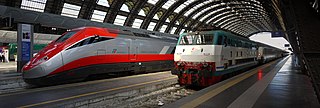
The Italian railway system is one of the most important parts of the infrastructure of Italy, with a total length of 24,567 km (15,265 mi) of which active lines are 16,832 km (10,459 mi). The network has recently grown with the construction of the new high-speed rail network. Italy is a member of the International Union of Railways (UIC). The UIC Country Code for Italy is 83.

The Alstom Coradia LINT is an articulated railcar of the Alstom Coradia family manufactured by Alstom since 1999, offered in diesel and hydrogen fuel models. The acronym LINT is short for the German "leichter innovativer Nahverkehrstriebwagen". It was designed by Linke-Hofmann-Busch and has been distributed as part of Alstom's Coradia family.

Chemins de fer de la Corse is the name of the regional rail network serving the French island of Corsica. It is centred on the town of Ponte Leccia, from which three main lines radiate to Ajaccio, Bastia, and Calvi. The section following the northwest coastline between L'Île-Rousse and Calvi, known as the Balagne line, gives access to many beaches and is very popular with tourists.
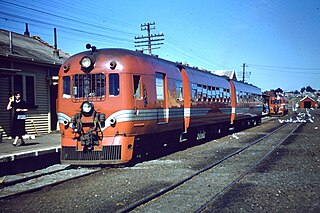
The NZR RM class 88-Seaters were a class of railcar used in New Zealand. New Zealand Government Railways (NZR) classified them as RM (Rail Motor), the notation used for all railcars, numbering the 35 sets from RM100 to RM134. They were the most numerous railcars in NZR service. Their purchase and introduction saw the demise of steam-hauled provincial passenger trains and mixed trains, and was part of a deliberate effort to modernise NZR passenger services at a time of increasing competition from private motor vehicles. Being diesel powered and lighter the railcars were less expensive to operate and able to maintain quicker timetables, although they became plagued with mechanical and electrical problems, with a number of the classes eventually being turned into depowered locomotive-hauled carriages and reclassified as the AC class "Grassgrubs".
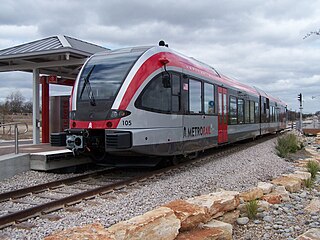
The Stadler GTW is an articulated railcar for local transport made by Stadler Rail of Switzerland. GTW stands for Gelenktriebwagen.

The National Railway Museum of Pietrarsa is close to the Naples–Portici railway.
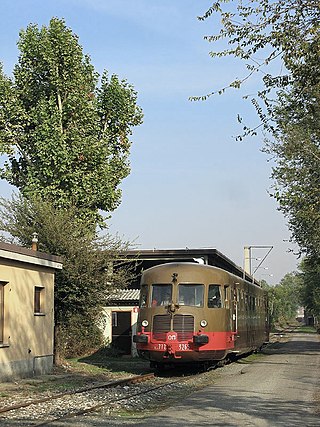
The ALn 772 series are a group of Diesel railcars built for the Italian public railway company Ferrovie dello Stato (FS) between the 1930s and the 1950s. As the first project in Italy to abandon the automobile-derived design and adopt a comprehensive "rolling stock" approach, it represents the link between the simple and sturdy Littorine and the modern Diesel units.

The Italian railway system is one of the most important parts of the infrastructure of Italy, with a total length of 24,227 km (15,054 mi) as of 2011.

The Y1 is a diesel-hydraulic standard gauge railcar. It is in use in Croatia, Serbia, Kosovo, Sweden and Uruguay. The production of the railcars was begun in 1980 by Kalmar Verkstad and Fiat Ferroviaria for Sweden.

Ferrovie Nord Milano is an Italian public transport company: the second largest railway company in Italy. It operates primarily in the northern Italian regions of Lombardy and Piedmont and in Canton Ticino in southern Switzerland. Listed on the Borsa Italiana, its main shareholders are the Lombardy Region (57.57%), Ferrovie dello Stato (14.5%) and Aurelia S.p.A. (3%).
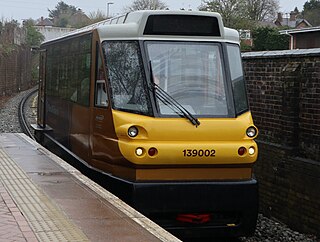
British Rail Class 139 is the TOPS classification for PPM60 model lightweight railcars built by Parry People Movers, for use on the British rail network. The class were originally built in 2008 for operation on the Stourbridge Town branch line following an extensive trial with a prototype registered as a Class 999 unit.

The ALn 668 series is a family of diesel railcars built by Fiat Ferroviaria between the 1950s and the 1980s. The trains were built for the Italian public railway company Ferrovie dello Stato (FS), now Trenitalia as well as many Italian private railway operators. Types derived from the class have been built for the railway companies of other nations. Most of the trains are still in service today.

The Milan–Bologna railway is the northern part of the traditional main north–south trunk line of the Italian railway network. It closely follows the ancient Roman Road, the Via Aemilia. The line was opened between 1859 and 1861 as a single-line railway, and was doubled between 1866 and 1894. It was electrified at 3,000 volts DC in 1938. High-speed trains on the route have used the parallel Milan–Bologna high-speed line since 13 December 2008.
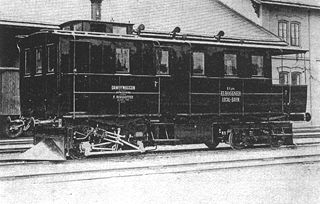
A steam railcar, steam motor car (US), or Railmotor (UK) is a railcar that is self powered by a steam engine. The first steam railcar was an experimental unit designed and built in 1847 by James Samuel and William Bridges Adams in Britain. In 1848 they made the Fairfield steam carriage that they sold to the Bristol & Exeter Railway, who used it for two years on a branch line.
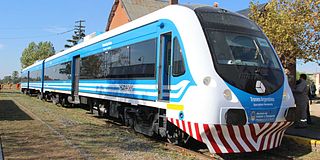
Materfer is an Argentine manufacturer of railway and road vehicles, located in the city of Ferreyra in Córdoba Province. The company was established by Fiat Concord in the late 1950s, being its subsidiary until 1980 when Sevel Argentina took over Fiat vehicles.

The 7131 was an Argentine diesel multiple unit class, first produced in Italy by Fiat Ferroviaria, then licensed to Argentine company Materfer to continue the manufacturing. Those railcars were introduced in the 1960s to replace the existing rolling stock of most of the urban services of Argentina, such as Roca, Urquiza, Mitre and Sarmiento lines.
The Naples–Foggia railway is an Italian railway line connecting Naples, in Campania, with Foggia, in Apulia, crossing the Apennines at the saddle of Ariano through a series of tunnels.



















